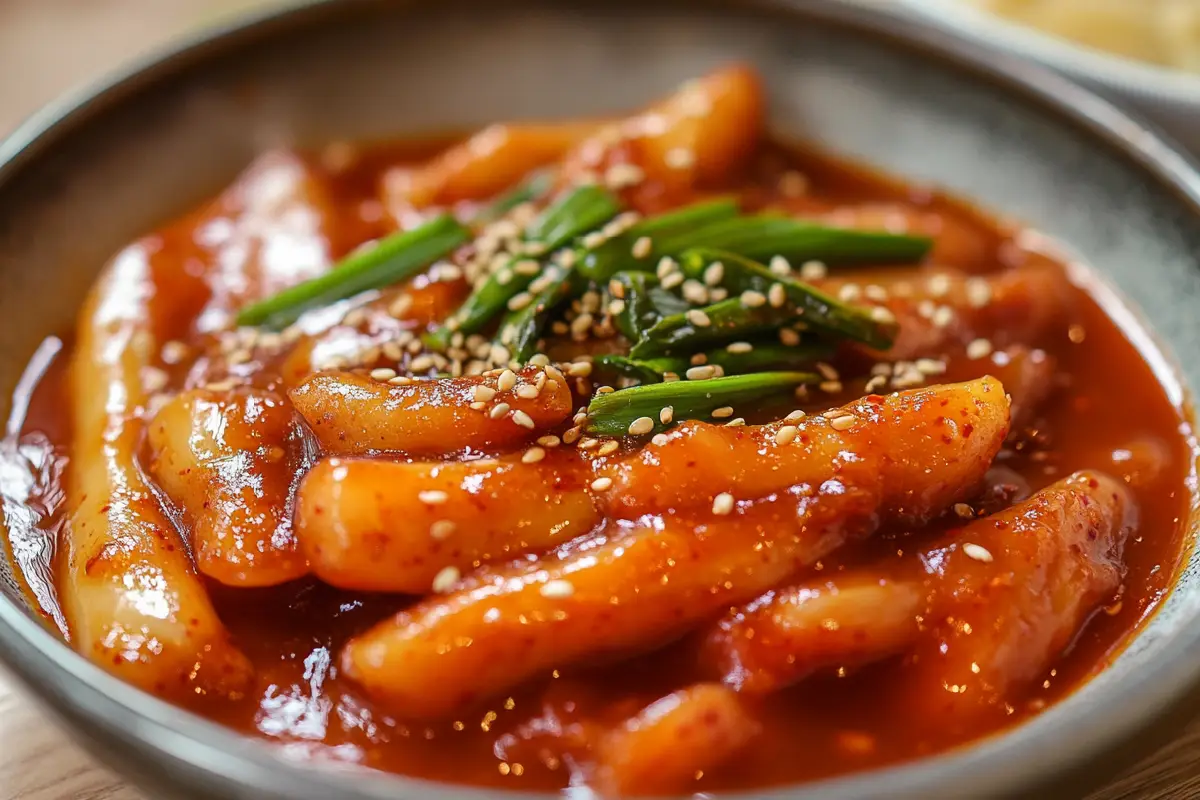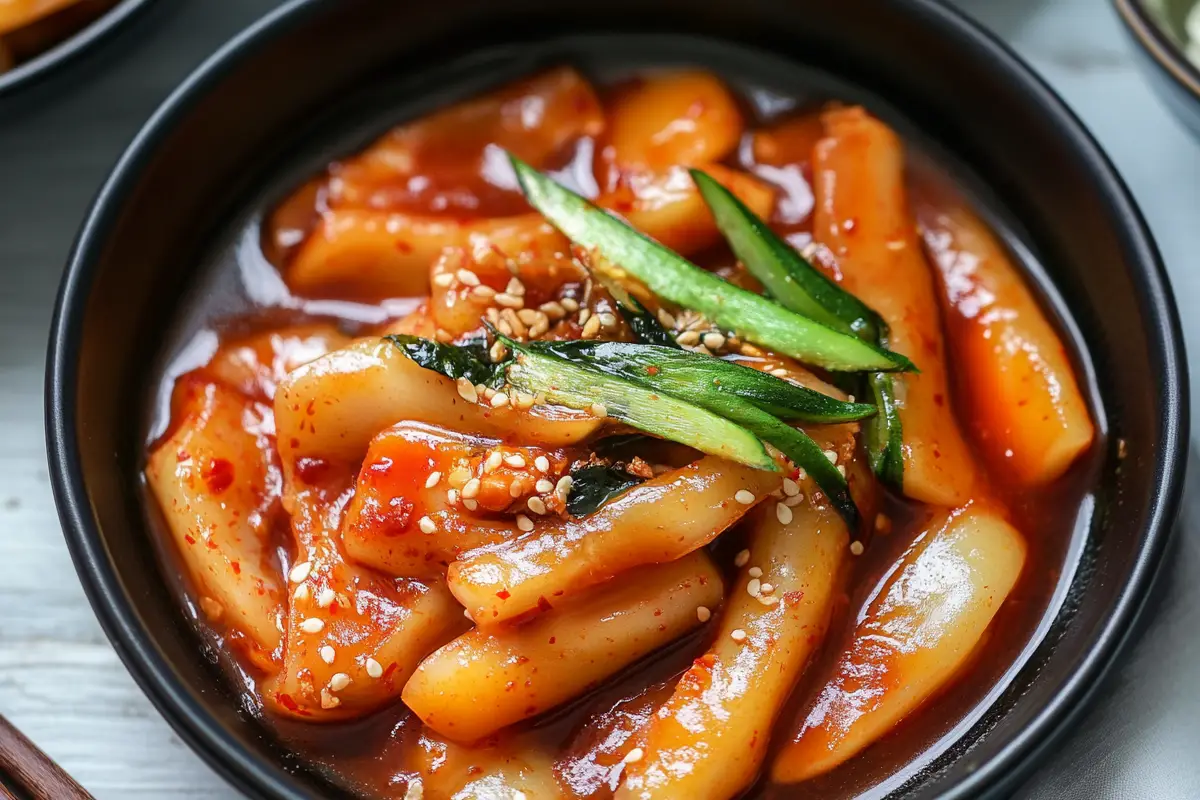Tteokbokki is one of Korea’s most iconic and beloved street foods, known for its spicy, savory, and slightly sweet flavors, with chewy rice cakes as the star ingredient. However, making homemade tteokbokki that perfectly mirrors its chewy, restaurant-quality texture can be tricky. Many people often ask, “Why is my homemade tteokbokki not chewy?” This detailed guide explores the most common mistakes and provides practical tips to help you achieve the perfect chewy texture at home.
Common Cooking Mistakes That Explain Why My Homemade Tteokbokki Is Not Chewy
Several factors could be preventing your tteokbokki from turning out as chewy as you’d like. Let’s look at the most common reasons and how to avoid them.
1. Using the Wrong Type of Rice Flour
One of the most common reasons for non-chewy tteok is using the wrong kind of rice flour. There are two main types of rice flour used in Korean cooking: glutinous rice flour (sweet rice flour) and non-glutinous rice flour. If you use non-glutinous rice flour, the rice cakes will lack elasticity and will become crumbly rather than chewy.
Glutinous Rice Flour:
- Known for its high starch content, which makes the dough sticky and elastic.
- Essential for making chewy rice cakes (like tteokbokki).
- Provides the chewiness that is a signature characteristic of the dish.
Non-Glutinous Rice Flour:
- Lacks the starch needed for elasticity.
- Results in a firmer, crumbly texture.
- Typically used in other types of rice cakes but not for tteokbokki.
If you’re making your rice cakes from scratch, always use glutinous rice flour for optimal chewiness. For a step-by-step guide to making chewy rice cakes at home, check out this recipe on making rice cakes.
2. Not Kneading the Dough Enough
Kneading is critical for creating the right texture in homemade rice cakes. If you don’t knead the dough enough, the rice cakes will lack the elasticity and stretch that make them chewy.
- Proper kneading technique: You should knead the dough for at least 10 minutes until it’s soft, smooth, and pliable. This process helps develop the starch in the rice flour, leading to better chewiness in the final product.
- Resting the dough: After kneading, let the dough rest for 30 minutes to an hour. Resting allows the starch to fully hydrate and creates a softer, chewier texture.
3. Insufficient Soaking of Store-Bought Tteok
If you’re using store-bought rice cakes, soaking them before cooking is crucial. Pre-packaged tteok tends to dry out during storage, and without soaking, they won’t absorb the sauce or cook evenly. Dry rice cakes can become hard, brittle, or tough during cooking.
Pro tip: Soak store-bought rice cakes in cold water for at least 30 minutes. This process rehydrates the rice cakes, softens them, and ensures they become chewy during cooking.
4. Overcooking or Undercooking the Rice Cakes
Getting the cooking time right is essential to achieving chewy rice cakes. Here’s what can go wrong:
- Overcooking: If you overcook the rice cakes, they can become mushy and lose their structure, which diminishes their chewy texture. Overcooked tteok can also dissolve into the sauce, leaving you with a sticky mess.
- Undercooking: Conversely, undercooked tteok will be hard and unpleasant to chew. The rice cakes won’t have enough time to absorb the sauce, resulting in an uneven texture.
Cooking tip: Simmer the rice cakes gently in the sauce, and monitor them closely. Rice cakes usually take about 8-10 minutes to cook through. Avoid boiling them at high heat, as this can lead to overcooking.
5. Stale or Low-Quality Ingredients
The quality of your ingredients plays a significant role in the final texture of your tteokbokki. Using stale or low-quality rice flour, for example, can lead to a tough or crumbly texture in the rice cakes.
- Choose fresh ingredients: Always use fresh rice flour if you’re making rice cakes from scratch. For store-bought tteok, opt for brands known for high-quality rice cakes to ensure chewiness.
- Ingredient freshness: Fresh ingredients result in better elasticity and overall texture in your final dish.
The Importance of Using the Right Rice Flour

The choice of rice flour is perhaps the single most important factor when it comes to making chewy tteokbokki. Without glutinous rice flour, it’s almost impossible to achieve the texture that makes this dish so satisfying.
Glutinous Rice Flour (Sweet Rice Flour)
This type of flour is made from sticky rice, which has a high starch content. The starches in the flour give the rice cakes their characteristic chewy, elastic texture. Glutinous rice flour is essential for creating the stretchy dough needed for tteokbokki.
Non-Glutinous Rice Flour
Unlike glutinous rice flour, non-glutinous rice flour doesn’t provide the elasticity needed for chewy rice cakes. This type of flour results in a firmer, more crumbly rice cake, which isn’t suitable for tteokbokki.
Cooking tip: Always use glutinous rice flour if you want your rice cakes to turn out chewy. For a detailed recipe using the correct ingredients, refer to this step-by-step rice cake recipe.
Common Cooking Mistakes That Ruin Texture
Even if you use the correct ingredients, cooking technique is key. Below are some common mistakes that can prevent your tteokbokki from achieving its signature chewiness.
1. Boiling at Too High a Temperature
Boiling the rice cakes at a high temperature can cause them to become too soft and lose their chewy texture. High heat also increases the risk of overcooking the rice cakes, causing them to break down in the sauce.
Solution: Simmer the rice cakes over medium or low heat. A gentle simmer allows the rice cakes to cook evenly while retaining their chewiness.
2. Not Soaking Store-Bought Rice Cakes
Store-bought rice cakes can dry out in their packaging, and without soaking, they won’t absorb the sauce properly or achieve a soft, chewy texture.
Solution: Soak store-bought rice cakes in cold water for at least 30 minutes before cooking. This rehydrates the rice cakes, making them soft and chewy when cooked.
3. Overcooking the Rice Cakes
Rice cakes that are cooked too long will lose their chewy texture and become mushy. This happens when the rice cakes are left simmering in the sauce for too long or when the heat is too high.
Solution: Monitor the cooking time closely and cook the rice cakes for no more than 8–10 minutes. You want the rice cakes to be cooked through but still firm and chewy.
4. Stirring Too Much
Over-stirring can cause the rice cakes to break apart, which will ruin the texture.
Solution: Stir gently and infrequently. Let the rice cakes cook undisturbed for most of the cooking time to prevent them from falling apart.
How to Make Chewy Tteokbokki at Home and Fix Texture Issues
If you’re ready to make chewy tteokbokki at home, follow these key steps to ensure success.
1. Use Glutinous Rice Flour
As mentioned earlier, glutinous rice flour is essential for creating the chewy texture. Be sure to choose the correct type of flour when making rice cakes from scratch.
2. Knead the Dough Properly
Kneading the dough is critical for creating elasticity in the rice cakes. Knead the dough for at least 10 minutes until it’s soft and pliable.
3. Soak Store-Bought Rice Cakes
If you’re using store-bought rice cakes, soak them in cold water for at least 30 minutes before cooking to ensure they absorb the sauce and soften properly.
4. Cook Gently
Avoid boiling the rice cakes at high heat. Instead, simmer them gently in the sauce for 8–10 minutes, or until they’re cooked through but still chewy.
For a more detailed guide on how to make tteokbokki, you can refer to this easy rice cake recipe.
How Temperature and Cooking Time Impact Texture
Cooking time and temperature are critical factors that determine the texture of your rice cakes. Here’s a breakdown of how each impacts your tteokbokki:
Temperature
- Low to medium heat: Allows for even cooking without breaking down the rice cakes. Simmering the rice cakes at a gentle heat ensures they stay chewy.
- High heat: Boiling the rice cakes at high heat can overcook them, making them mushy or dissolving them into the sauce.
Cooking Time
- 8–10 minutes: This is the ideal cooking time for rice cakes. Any less, and they’ll be undercooked; any more, and they’ll turn mushy.
Monitor the rice cakes closely during cooking, stirring occasionally to ensure they cook evenly without falling apart.
Storing and Reheating Tteokbokki Without Losing Chewiness
While tteokbokki is best enjoyed fresh, leftovers can still be enjoyed if stored and reheated correctly. Here’s how to preserve the texture:
1. Storing Leftover Tteokbokki
Store leftover rice cakes in an airtight container. To prevent them from drying out, you can also wrap them in plastic wrap. Properly stored rice cakes will last for 1–2 days in the fridge.
2. Reheating Tteokbokki
To reheat, place the rice cakes in a pan with a little water or extra sauce. Heat them slowly over low heat to prevent them from becoming too dry.
3. Reviving Hard Rice Cakes
If your rice cakes become hard after storage, soak them in warm water for 10–15 minutes before reheating to help soften them.
Why Sauce Consistency Affects Why My Homemade Tteokbokki Is Not Chewy
While the sauce doesn’t directly affect the chewiness of the rice cakes, it plays a crucial role in enhancing the overall texture and flavor of the dish. A well-balanced sauce will coat the rice cakes and complement their chewy texture.
Key Sauce Ingredients:
- Gochujang: This Korean red chili paste provides the heat and depth of flavor that tteokbokki is known for.
- Soy Sauce: Adds a salty, umami base that balances the sweetness and heat of the dish.
- Sugar or Corn Syrup: Balances the spiciness of the gochujang, adding a sweet note that completes the sauce.
A thick sauce clings to the rice cakes, ensuring that every bite is flavorful and enhances the chewy texture.
FAQs: Why Is My Homemade Tteokbokki Not Chewy? Troubleshooting Tips
Why is my tteokbokki hard after cooking?
Your tteokbokki may be hard because the rice cakes weren’t soaked properly before cooking or were undercooked. Soaking store-bought rice cakes in cold water for 30 minutes can help soften them before cooking.
How can I make store-bought rice cakes softer?
To soften store-bought rice cakes, soak them in cold water for at least 30 minutes before cooking. This helps them rehydrate and ensures they’ll be soft and chewy once cooked.
Can I use all-purpose flour instead of rice flour?
All-purpose flour won’t give you the chewy texture needed for tteokbokki. The chewiness comes from the high starch content in glutinous rice flour, which can’t be replicated with all-purpose flour.
Conclusion: Fixing Why My Homemade Tteokbokki Is Not Chewy for Perfect Results

Making the perfect chewy tteokbokki at home is achievable with the right ingredients, preparation techniques, and attention to detail. By using glutinous rice flour, kneading the dough properly, and cooking the rice cakes at the right temperature, you can ensure that your tteokbokki will have the ideal chewy texture every time. Follow these tips and you’ll master this beloved Korean dish in no time.
For more tips and a detailed recipe, be sure to check out this easy rice cake recipe.

